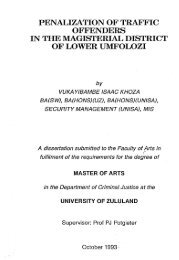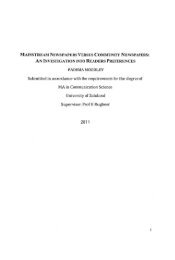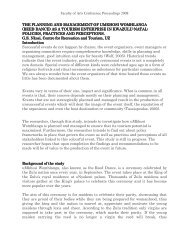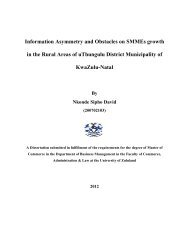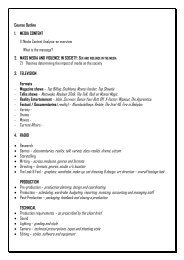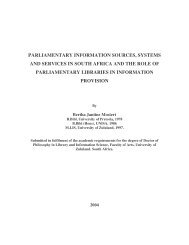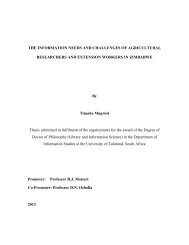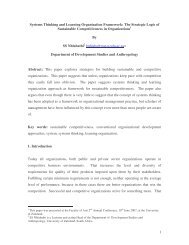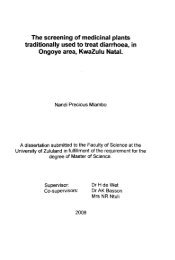- Page 3 and 4:
EXPRESSING EMOTION How emotion is e
- Page 5 and 6:
Abstract EXPRESSING EMOTION How emo
- Page 7 and 8:
Acknowledgement The NRF for the fun
- Page 9 and 10:
Chapter 4 49 The grammatical encodi
- Page 11 and 12:
Underlying Factors 135 Scope ofthe
- Page 13 and 14:
Distributive And Integrative Negoti
- Page 15 and 16:
Imposing Deadlines 288 Using The De
- Page 17 and 18:
Chapter 1 INTRODUCTION OF My THESIS
- Page 19 and 20:
Chapter 2 ST.HEJ'.lENT OF PROBLEMS
- Page 21 and 22:
language; };> An outline will be gi
- Page 23 and 24:
Emotions are considered to be react
- Page 25 and 26:
exposing people to onions, which ma
- Page 27 and 28:
It still has to be resolved whether
- Page 29 and 30:
of activity, the overwhelming evide
- Page 31 and 32:
Sternberg (1998: 542), Robert Plutc
- Page 33 and 34:
pinpointed. Most people feel anxiet
- Page 35 and 36:
According to Bulmer (1975) hate is
- Page 37 and 38:
Brand and Graves (1994:165) describ
- Page 39 and 40:
Primary appraisal, which is about w
- Page 41 and 42:
Values and Value Systems Values are
- Page 43 and 44:
Sternberg (1998:551) makes the poin
- Page 45 and 46:
THE SOCIAL CONSTRUCTlVIST ApPROACH
- Page 47 and 48:
RATIONALISATION According to Bulmer
- Page 49 and 50:
Bulmer (1975:vi) defines empathy as
- Page 51 and 52:
Chapter 4 THE GRAM.\L\TIC\l. ENCODI
- Page 53 and 54:
SOCIAL EVENT DEMOTION ACTION RESPON
- Page 55 and 56:
from an anthropological point of vi
- Page 57 and 58:
symbolic reference is not understoo
- Page 59 and 60:
The role ofnouns in the expression
- Page 61 and 62:
In the choice ofa vocative Combrink
- Page 63 and 64:
Class 3 singular: izimu (an ogre) >
- Page 65 and 66:
Titles as vocatives Title vocatives
- Page 67 and 68:
"Jy. staan regop en trek in ;ou boe
- Page 69 and 70:
THE ROLE OF VERBS IN THE EXPRESSION
- Page 71 and 72:
Stre/ende woorde (Soothing words) W
- Page 73 and 74:
Eksaljou help. (I shall help you) D
- Page 75 and 76:
lsiZulu is said to have nine tone p
- Page 77 and 78:
CONCLUSION This chapter I demonstra
- Page 79 and 80:
organism to the world through such
- Page 81 and 82:
with the latter "the state and what
- Page 83 and 84:
(ii) The directive class of speech
- Page 85 and 86:
With Intentional states a belief is
- Page 87 and 88:
circumstances by those in certain i
- Page 89 and 90:
Directives: advising, admonishing,
- Page 91 and 92:
negotiation situations. Deterring,
- Page 93 and 94:
HI insist that you go to London. "
- Page 95 and 96:
deductions. Implications and inclus
- Page 97 and 98:
Secondly, there is a modal meaning
- Page 99 and 100:
When you permit a person bythe use
- Page 101 and 102:
These modals, like must, denote obl
- Page 103 and 104:
DISTAl FORMS OF THE ROOT MODAlS Cou
- Page 105 and 106:
He will buy a car next year. When s
- Page 107 and 108:
(He can play rugby well) Hulle kon
- Page 109 and 110:
(You only have to translate the fir
- Page 111 and 112:
Werklikheid/ feitelikheid (Realityl
- Page 113 and 114:
According to Van Schoor (1982:271)
- Page 115 and 116:
MOET (must) is the central auxiliar
- Page 117 and 118:
(Will you help me?) Sal jy my nie h
- Page 119 and 120:
Chapter 6 EMOTION DURING CONFLICT T
- Page 121 and 122:
important to understand human needs
- Page 123 and 124:
Self-actualisation needs are the la
- Page 125 and 126:
pacts. Mersham and Skinner further
- Page 127 and 128:
station or going to a particular ch
- Page 129 and 130:
in each other's welfare negotiate,
- Page 131 and 132:
The scoping of a conflict is import
- Page 133 and 134:
may wish for or fight for the total
- Page 135 and 136:
}> How these groups mobilise i.e. i
- Page 137 and 138:
perceived goals and interests, cult
- Page 139 and 140:
Related to recognizing related disp
- Page 141 and 142:
egularly to see which ofthe factors
- Page 143 and 144:
eventually engaging in the armed st
- Page 145 and 146:
Stereotype-Breaking Action Using di
- Page 147 and 148:
that of Cyril Ramaphosa ofthe ANC a
- Page 149 and 150:
Mediation is usually successful in
- Page 151 and 152:
A mediator can also help the groups
- Page 153 and 154:
oth internally and externally. Thes
- Page 155 and 156:
this kind of narrative about the So
- Page 157 and 158:
ASSESSING YOUR OPPONENT'S POSITION
- Page 159 and 160:
SEARCHING FOR HIDDEN MOTIVES It has
- Page 161 and 162:
MOTIVATION Motivation and emotion o
- Page 163 and 164:
stress levels are still Iow. Andrea
- Page 165 and 166:
een violated like when one feels an
- Page 167 and 168:
Conflict Mapping Wehr states how th
- Page 169 and 170:
another instead of selfishly sticki
- Page 171 and 172:
Conflict Intrapersonal Interpersona
- Page 173 and 174:
government (KIug 2000:1) This happe
- Page 175 and 176:
Conflict transformation also means,
- Page 177 and 178:
empowennent or recognition ofoppone
- Page 179 and 180:
CONSTRUCTIVE CONFRONTATION Construc
- Page 181 and 182:
force in resolving the conflict. Ta
- Page 183 and 184:
etain the majority it gained in a p
- Page 185 and 186:
CRISIS MANAGEMENT DURING CONFLICT T
- Page 187 and 188:
It is advisable to be prepared for
- Page 189 and 190:
augment your team and to avoid this
- Page 191 and 192:
the factors that modifY the general
- Page 193 and 194:
Tuesday, September 30, 1997) Howeve
- Page 195 and 196:
e scrutinised as well as the role o
- Page 197 and 198:
pre-negotiation is handIed well it
- Page 199 and 200:
Third parties or intennediaries als
- Page 201 and 202:
epresentatives of the government an
- Page 203 and 204:
~ If the surroundings at the neutra
- Page 205 and 206:
will take longer. Therefore Fuller
- Page 207 and 208:
The agenda for the CODESA negotiati
- Page 209 and 210:
elections. After the elections the
- Page 211 and 212:
The disadvantage is that some offer
- Page 213 and 214:
struggle into dialogue leaving nega
- Page 215 and 216:
constituent assembly and an interim
- Page 217 and 218:
At level 2 integrative agreement is
- Page 219 and 220:
Insecure. Emotional Stability This
- Page 221 and 222:
THE EFFECT OF MEMBER PERSONALITY FA
- Page 223 and 224:
Barry and Friedman (1998:348) defin
- Page 225 and 226:
oute" and the "heuristic or periphe
- Page 227 and 228:
persistence of persuasion e.g. "inc
- Page 229 and 230:
fact that the people were being kil
- Page 231 and 232:
you want them to do and feel comfor
- Page 233 and 234:
Samaritan" (Fuller 1991:91) will ne
- Page 235 and 236:
that splitting the difference shoul
- Page 237 and 238:
The occurrence of violence before a
- Page 239 and 240:
person with real power, she is also
- Page 241 and 242:
to reason, then you will rather neg
- Page 243 and 244:
to be for that purpose. He had also
- Page 245 and 246:
You should also ask yourselfifthe o
- Page 247 and 248:
unacceptable offer, do not be blunt
- Page 249 and 250:
and evaluation of the offer. Changi
- Page 251 and 252:
These people, therefore, need to be
- Page 253 and 254: constituency by not agreeing to the
- Page 255 and 256: your adversary may persuade you to
- Page 257 and 258: If the criteria for detennining the
- Page 259 and 260: services and other areas of public
- Page 261 and 262: after the deal is reached, are over
- Page 263 and 264: display one's frustration and emoti
- Page 265 and 266: suits you. It must be noted that du
- Page 267 and 268: TAKING ADVANTAGE OF DIVISIONS IN TH
- Page 269 and 270: (1992:196) recommends that one shou
- Page 271 and 272: prisoners and other individuals. Th
- Page 273 and 274: Bullying Tactics It was discussed e
- Page 275 and 276: Fuller (1992:206) mentions other ty
- Page 277 and 278: - Do the parties all know their alt
- Page 279 and 280: IGNORING THEM AND CONTINUING WITH D
- Page 281 and 282: up in jail for human rights violati
- Page 283 and 284: concessions have been made. However
- Page 285 and 286: extremists were arrested. That made
- Page 287 and 288: in negotiations, it helps to shift
- Page 289 and 290: what they are saying during discuss
- Page 291 and 292: Involving Higher Level Participatio
- Page 293 and 294: international law during the compro
- Page 295 and 296: what his problem is. If you succeed
- Page 297 and 298: confederation ofhomelands each with
- Page 299 and 300: apology and forgiveness and it cons
- Page 301 and 302: Desmond Tutu as chairperson ofthe C
- Page 303: long way towards promoting the clim
- Page 307 and 308: ecause of the frequent exchange mak
- Page 309 and 310: in the case of a buyer who is only
- Page 311 and 312: limit". At a more complex level the
- Page 313 and 314: Barry and Oliver (1996) mention fiv
- Page 315 and 316: AFFECT RELATED To SETTLEMENTS AND O
- Page 317 and 318: Both affect sequences are a result
- Page 319 and 320: our behaviour during negotiation; w
- Page 321 and 322: In the same page Thompson (1998) sa
- Page 323 and 324: accept." Jackall quotes an example
- Page 325 and 326: called "a manic-depressive," a term
- Page 327 and 328: with pauses or whether he speaks co
- Page 329 and 330: Contagion According to an experimen
- Page 331 and 332: Freedom To Express Emotion This dep
- Page 333 and 334: Controlled And Deliberate Emotional
- Page 335 and 336: who is perceived to be disliked by
- Page 337 and 338: especially in social contexts like
- Page 339 and 340: He also found that negotiators who
- Page 341 and 342: Ekman (1999) does not consider a br
- Page 343 and 344: There is also transactive memory wh
- Page 345 and 346: However, they can also enhance or w
- Page 347 and 348: Chapter 7 CONCLUSIONS This has been
- Page 349 and 350: BmLIOGRAPHY AUTHORED REFERENCES All
- Page 351 and 352: Barry, Bruce (with G.L. Stewart), 1
- Page 353 and 354: Fauconnier. Gilles 1995 Mental Spac
- Page 355 and 356:
Langacker, Ronald W. 1993. Foundati
- Page 357 and 358:
Taylor, John R. 1991 Linguistic Cat
- Page 359 and 360:
NON-AuTHORED REFERENCES Conflict Re
- Page 361 and 362:
Conflict Research Consortium 1998 I
- Page 363 and 364:
Conflict Research Consortium 1998 R



